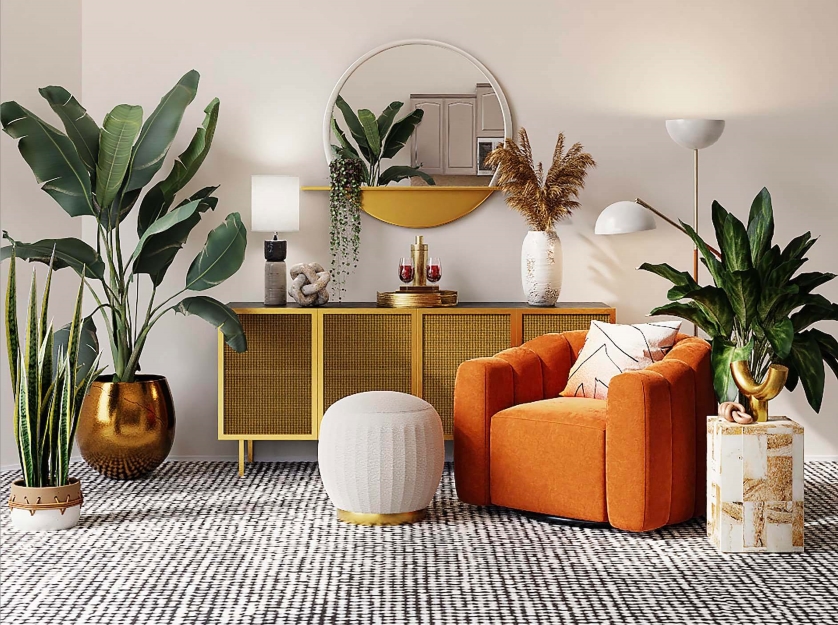The decision to incorporate greenery into your living space often comes with a question: Should you choose fake or real ones? This debate has captured the attention of plant enthusiasts and design connoisseurs alike. Each option brings its own set of advantages and challenges. Whether you’re drawn to the charm of real plants or the practicality of artificial plants, understanding their benefits and drawbacks is key to making the right choice for your lifestyle and environment.
Contents
The Low-Maintenance Option
The faux plants have become popular for those who love greenery but don’t have the time or skills to care for actual plants. They offer a convenient way to beautify spaces without the challenges of real plant care.
Benefits of Fake Plants

No Maintenance Required
Unlike real plants, decorative fake plants don’t need watering, pruning, or fertilising. They stay lush and green year-round, making them perfect for busy individuals or those who lack a green thumb.
Durable and Long-Lasting
Made from materials like plastic or silk, artificial plants can withstand various conditions without wilting or dying. This durability ensures they look great for years with minimal effort.
Allergy-Friendly
Real plants can trigger allergies due to pollen or mould. Fake plants eliminate this issue, offering a sneeze-free way to enjoy greenery.
Versatile for Any Space
From dimly lit rooms to spaces with fluctuating temperatures, fake plants thrive where real plants might struggle. They’re an excellent choice for offices, bathrooms, or areas without natural light.
Drawbacks of Fake Plants
Lack of Air-Purifying Benefits
Real plants help improve air quality by absorbing carbon dioxide and releasing oxygen. Artificial plants lack this natural benefit, making them purely decorative.
May Not Look as Natural
While high-quality artificial plants for sale can mimic the appearance of real plants, cheaper options may look plastic or unrealistic, potentially detracting from the ambience of your space.
Nature’s Air Purifiers
Real plants bring life and vibrancy to any environment, offering a range of physical and psychological benefits. However, they also come with responsibilities that require consistent effort and care.
Benefits of Real Plants
- Improved Air Quality – Plants like peace lilies and spider plants act as natural air purifiers, removing toxins and increasing oxygen levels. This can contribute to a healthier indoor environment.
- Reduced Stress and Anxiety – Studies show that being around greenery can lower stress levels and promote relaxation. Caring for plants can also be a therapeutic activity.
- Enhanced Mood and Productivity – Adding real plants to your workspace or home can boost your mood and improve focus, making them ideal for creating a calming and productive atmosphere.
- Aesthetic Appeal – The organic beauty of live plants, with their vibrant colours and unique textures, adds an authentic and dynamic element to any décor.
Drawbacks of Real Plants
- Require Maintenance – Real plants need regular watering, pruning, and occasional fertilising. Neglect can lead to wilting, pests, or even death, making them a commitment.
- Susceptible to Pests and Diseases – Real plants can attract insects or develop diseases, which can be challenging to manage, especially for beginners.
Choosing the Right Plants for Your Space

When deciding between real and fake, consider your lifestyle, preferences, and the specific conditions of your space.
Ideal for Nature Lovers
If you’re new to plant care, start with hardy plants like succulents, snake plants, or pothos. These species require minimal watering and are forgiving of occasional neglect. Choose plants that match the lighting in your space. For instance, ferns thrive in indirect light, while cacti prefer bright sunlight.
Perfect for Convenience
Invest in premium artificial plants made from silk or high-grade plastic for a lifelike appearance. Brands specialising in artificial plants often offer designs that mimic real leaves, stems, and soil. Use artificial plants in areas where real plants might not thrive, such as bathrooms, basements, or rooms with minimal natural light.
Tips for Blending Real and Fake Plants
If you’re torn between the two options, consider combining real and artificial plants to enjoy the best of both worlds. Use real plants in spaces with ample light and where maintenance is manageable, and supplement with fake ones in harder-to-reach areas or low-light corners.
To Recap
The choice between real and artificial ultimately depends on your priorities. Real plants bring the benefits of improved air quality and a connection to nature but require time and effort to maintain. For real plant enthusiasts, consider popular exotic plants like orchids, birds of paradise, or bonsai trees. On the other hand, artificial plants offer convenience, durability, and allergy-friendly décor at the cost of lacking the natural charm and functionality of live greenery.
Whether you select a thriving pothos for your sunny corner or a sleek fake plant for your dim hallway, the goal is to create a space that feels welcoming and reflects your personality. Explore the best of both worlds by blending real plants with high-quality artificial plants for sale for a balanced and beautiful environment. No matter your choice, embracing greenery real or faux will undoubtedly enhance the ambience and energy of your living space.











